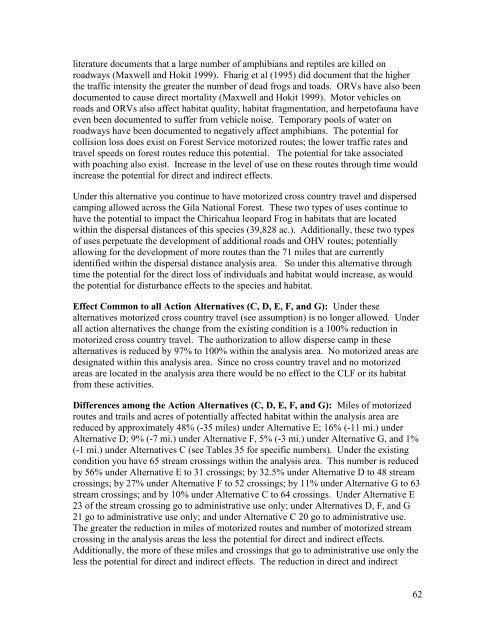Wildlife Specialist report
Wildlife Specialist report
Wildlife Specialist report
Create successful ePaper yourself
Turn your PDF publications into a flip-book with our unique Google optimized e-Paper software.
literature documents that a large number of amphibians and reptiles are killed on<br />
roadways (Maxwell and Hokit 1999). Fharig et al (1995) did document that the higher<br />
the traffic intensity the greater the number of dead frogs and toads. ORVs have also been<br />
documented to cause direct mortality (Maxwell and Hokit 1999). Motor vehicles on<br />
roads and ORVs also affect habitat quality, habitat fragmentation, and herpetofauna have<br />
even been documented to suffer from vehicle noise. Temporary pools of water on<br />
roadways have been documented to negatively affect amphibians. The potential for<br />
collision loss does exist on Forest Service motorized routes; the lower traffic rates and<br />
travel speeds on forest routes reduce this potential. The potential for take associated<br />
with poaching also exist. Increase in the level of use on these routes through time would<br />
increase the potential for direct and indirect effects.<br />
Under this alternative you continue to have motorized cross country travel and dispersed<br />
camping allowed across the Gila National Forest. These two types of uses continue to<br />
have the potential to impact the Chiricahua leopard Frog in habitats that are located<br />
within the dispersal distances of this species (39,828 ac.). Additionally, these two types<br />
of uses perpetuate the development of additional roads and OHV routes; potentially<br />
allowing for the development of more routes than the 71 miles that are currently<br />
identified within the dispersal distance analysis area. So under this alternative through<br />
time the potential for the direct loss of individuals and habitat would increase, as would<br />
the potential for disturbance effects to the species and habitat.<br />
Effect Common to all Action Alternatives (C, D, E, F, and G): Under these<br />
alternatives motorized cross country travel (see assumption) is no longer allowed. Under<br />
all action alternatives the change from the existing condition is a 100% reduction in<br />
motorized cross country travel. The authorization to allow disperse camp in these<br />
alternatives is reduced by 97% to 100% within the analysis area. No motorized areas are<br />
designated within this analysis area. Since no cross country travel and no motorized<br />
areas are located in the analysis area there would be no effect to the CLF or its habitat<br />
from these activities.<br />
Differences among the Action Alternatives (C, D, E, F, and G): Miles of motorized<br />
routes and trails and acres of potentially affected habitat within the analysis area are<br />
reduced by approximately 48% (-35 miles) under Alternative E; 16% (-11 mi.) under<br />
Alternative D; 9% (-7 mi.) under Alternative F, 5% (-3 mi.) under Alternative G, and 1%<br />
(-1 mi.) under Alternatives C (see Tables 35 for specific numbers). Under the existing<br />
condition you have 65 stream crossings within the analysis area. This number is reduced<br />
by 56% under Alternative E to 31 crossings; by 32.5% under Alternative D to 48 stream<br />
crossings; by 27% under Alternative F to 52 crossings; by 11% under Alternative G to 63<br />
stream crossings; and by 10% under Alternative C to 64 crossings. Under Alternative E<br />
23 of the stream crossing go to administrative use only; under Alternatives D, F, and G<br />
21 go to administrative use only; and under Alternative C 20 go to administrative use.<br />
The greater the reduction in miles of motorized routes and number of motorized stream<br />
crossing in the analysis areas the less the potential for direct and indirect effects.<br />
Additionally, the more of these miles and crossings that go to administrative use only the<br />
less the potential for direct and indirect effects. The reduction in direct and indirect<br />
62
















